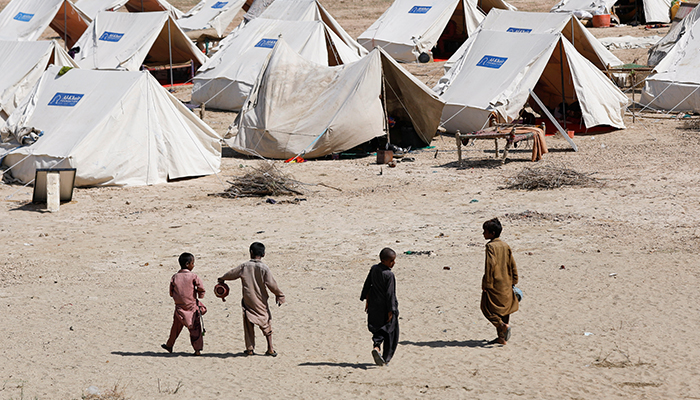Pakistan must fight for climate justice
Pakistan has been thrust into a crisis not of its own making, and it today stands at the epicenter of global climate injustice
September 22, 2022

Climate change has been termed as the gravest human rights violation in history and Pakistan is today a living testament to that assertion.
Over the past five months, the country has braved scorching heatwaves recording the hottest temperatures on the globe, flaming forest fires, enhanced glacial melt and is now facing an apocalyptic flood triggered by unforgiving monsoon rains and glacial bursts in the mountains.
This stream of freak events is already being scientifically and unequivocally linked to human-induced climate change.
Termed an “unprecedented climate catastrophe” by the United Nations, it has shocked the whole country with the ensuing human misery. A population of over 33 million is awash in suffering with over 1,400 killed, most of them small children, and 10 million people forcibly displaced to become hapless climate refugees in their own homeland.
As the static flood waters now threaten increased hunger, disease and poverty, the inescapable damage assessments are already running into billions ($30 billion as per some estimates) for the rescue, repair and massive rehabilitation.
Pakistan, however, does not deserve to be on this firing line.
According to the German Watch climate risk index, it remains one of the top ten countries most vulnerable to climate change although it contributes less than one per cent to the current global greenhouse gas emissions, is less than 0.5% of the historical carbon emissions while currently, it maintains one of the world's lowest per capita emissions.
Quite clearly, Pakistan is unjustly bearing the consequences for the reckless excesses of high carbon emitters which, according to Fiji Prime Minister Frank Bainmarama, are “responsible for what’s happening in Pakistan”.
Others, such as climate economist Jason Hickel, are citing this situation as a “straightforward case for climate reparations”, while Jeffery Sachs has termed it as a “fight for climate justice”, as the historic polluters are “exporting climate damages” to countries like Pakistan.
Quite clearly Pakistan has been thrust into a crisis, not of its own making, and it today stands at the epicentre of global climate injustice. It is a situation that it neither desires nor can sustain with its limited capacity and strained resources.
It needs to be assisted, not with pittance thrown in a begging bowl, but through reparations for climate damage that are justifiably and fairly due to it, given our carbon-polluting world.
The scale of the challenge, in both human and financial terms, is unprecedented and demands out-of-the-box financial solutions that need to be delivered innovatively, effectively and urgently. Two such solutions are possible.
The idea of distributing Special Drawing Rights (SDR), a special currency created by the IMF to support member state financial reserves, towards climate-vulnerable countries and linking it with spending on climate adaptation and enhancing disaster management infrastructure has been floating at the global level. This is the right time to deliver it in Pakistan. This will allow the country to free up desperately needed fiscal space to undertake not only immediate relief efforts but also direct resources to build back the heavily destroyed infrastructure in a climate-compatible manner.
Second, more than any other country, Pakistan desperately needs innovative climate financing. The country has already been globally recognized as a natural leader by organizations such as UNEP, IUCN and WEF.
It has been led by self-financing ecological initiatives building up nature-based climate resilience and the country’s green infrastructure. These include the ongoing “10 billion tree tsunami”, restoring over 1 million ha of degraded forests, and the “Protected areas initiative”, expanding the coverage of the protected area by 50% in just two years.
The ongoing ‘Recharge Pakistan’ initiative is designed to divert and utilize flood waters for wetlands restoration and groundwater recharge while Pakistan’s ‘Living Indus’ programme is aiming for the ecological repair and restoration of the Indus river system as the country’s climate adaptation backbone.
All these nature-based and climate resilience solutions were initiated by our previous government and established Pakistan’s leadership on climate and nature. This nature-positive drive now needs to be supported with relief, relaxation or restructuring of debt as well as provision of concessional nature financing.
This can be done through financial instruments such as a natural performance bond, nature policy-based lending or debt for climate swap.
Pakistan is ready to pilot these and has already been working with multilateral agencies in that direction. The final impetus needs to be given to make this happen.
At this moment of crisis, delivering Pakistan’s climate reparations through debt relief and innovative green financing will not only carve a pathway towards a climate-compatible recovery but also serve as a signal for justice and equity in an increasingly climate-fractured world.
The writer is former minister of climate change, former SAPM and former vice president of the IUCN. He tweets @aminattock and can be reached at [email protected]











